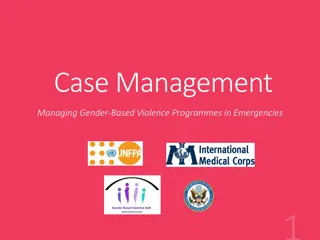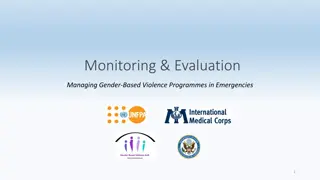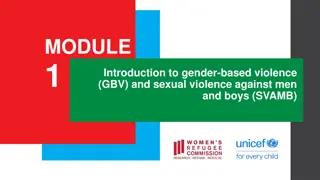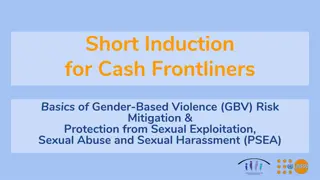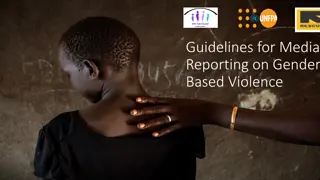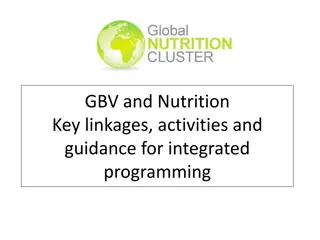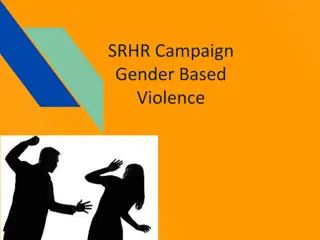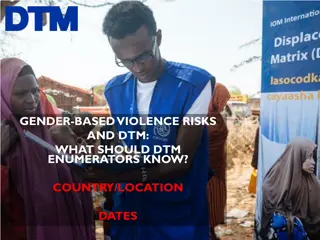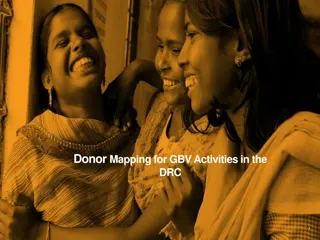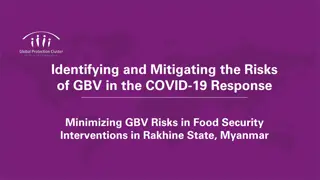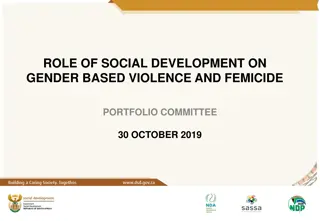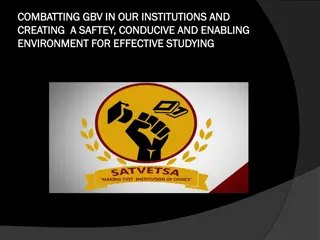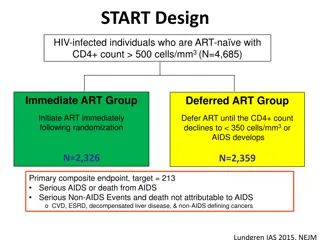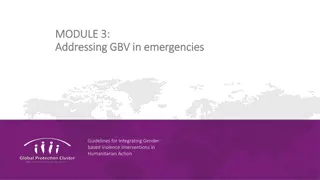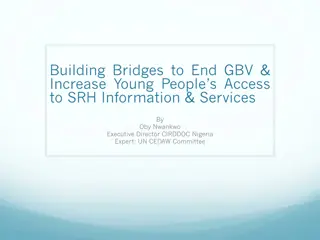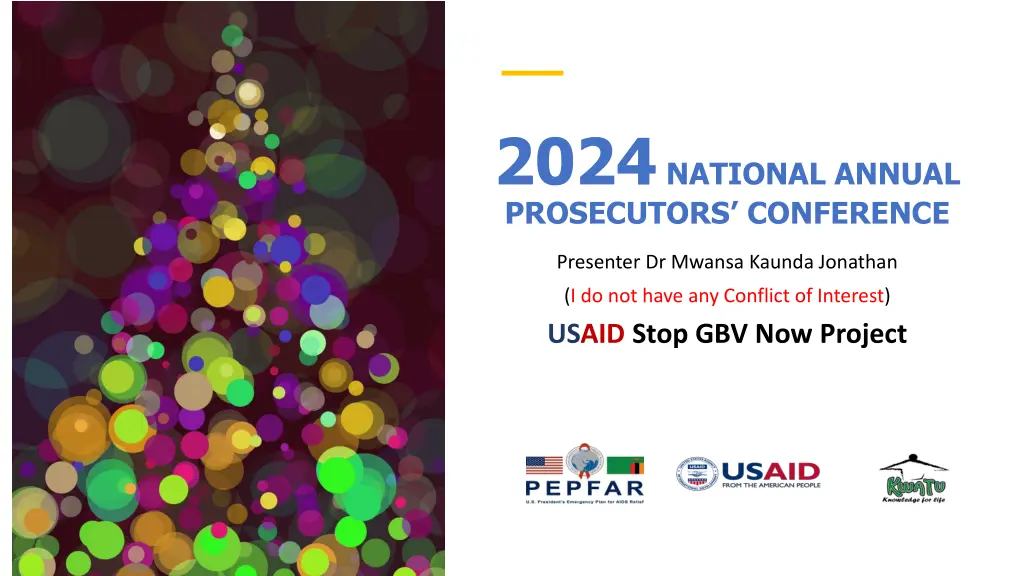
Medical Evaluation and Examination in Gender-Based Violence Cases
This comprehensive guide covers the essential steps in the medical evaluation and examination process for survivors of gender-based violence (GBV). From initial assessments to forensic evidence collection, learn about the importance of proper documentation and timing in these critical examinations to provide holistic care and support to survivors.
Download Presentation

Please find below an Image/Link to download the presentation.
The content on the website is provided AS IS for your information and personal use only. It may not be sold, licensed, or shared on other websites without obtaining consent from the author. If you encounter any issues during the download, it is possible that the publisher has removed the file from their server.
You are allowed to download the files provided on this website for personal or commercial use, subject to the condition that they are used lawfully. All files are the property of their respective owners.
The content on the website is provided AS IS for your information and personal use only. It may not be sold, licensed, or shared on other websites without obtaining consent from the author.
E N D
Presentation Transcript
2024 NATIONAL ANNUAL PROSECUTORS CONFERENCE Presenter Dr Mwansa Kaunda Jonathan (I do not have any Conflict of Interest) USAID Stop GBV Now Project
Outline Introduction Medical Evaluation Medical History Medical Examination Forensic Examination Police Medical Report ZP Form 32
5.7% 47% GBV Harmful norms Stigma and discrimination Discrepancy Statutory/cultural laws Punitive laws for KPs Lack of coordination Inadequate One Stop Centres (OSC) 14% Sexual 38 % Physical 39% Child Marriage Introduction
The medical evaluation of GBV has several immediate goals. Evaluation To identify injuries and/or conditions that require immediate treatment To evaluate for, and possibly reduce the risk of HIV and/or pregnancy To screen for / or diagnose sexually transmitted infections To document findings of potential forensic value
Complete Medical Examination Includes Multi-Method Regional examination General Physical Examination Medical history Specialized exam techniques are always required Use of Collection of forensic material magnification
Medical History 1 2 3 4 Must be Comprehensive and clear . Documented in survivor s own words. None speculative. A summary of important positives and negatives always must be included .
Identifies features that corroborate the survivor s story or provide a rational alternative explanation for the presenting complaint. Identifies complications of assault/abuse (injuries, infections or pregnancy) requiring immediate medical attention. Medical Examination Directs focus of forensic evidence collection. Document findings in a manner that supports any legal actions.
Timing of examination Acute Examination: within 72 hrs of sexual assault. Window for collecting forensic evidence. Non-Acute Examination: after 72 hrs of sexual assault. Chances of finding forensic evidence reduced. 5/10/2025 8
Forensic goal: Provide an independent reconstruction of the events in question that is: Accurate Objective Scientifically sound Evidence-based DNA is the gold standard Contact Identity Forensic Examination
Available Forensic technology to prevent/respond to GBV in Zambia: DNA PCR and Crimelite technologies to identify blood and other biological fluids, material fibres and/or hairs left at the scene or on victims as forensic evidence (e.g., rape or murder). Digital Forensics/Cybercrimes Analysis (e.g. Celebrite equipment to detect abuse in mobile devices, social media, etc) Fingerprints (Biometrics) technology. Automated Fingerprint Identification System (AFIS) used to process fingerprints from the scenes to link to possible suspects or perpetrators of crime e.g. rape/murder.
Successes /failures Successes: Failures: Willingness and desire by the country to use forensic technology as a means to solve GBC s and other cases. Limited Forensic facilities only available in Lusaka whereas other regions remain with a constrained access to such facilities. lack of adequate numbers of well trained human resource to collect Forensic evidence. Lack of an established DNA Population Database leading to delays in finalizing cases and an increased backlog of cases.
Challenges Lack of easy access to Forensic facilities for GBC s in most regions outside of Lusaka. Lack of adequately trained manpower to conduct these examinations. Limited public awareness about the importance of the Forensic Evidence in the Criminal Justice System
Recommendations for more effective use of Forensic Evidence Increased accessibility to Forensic facilities for most GBC s especially from areas outside of Lusaka Establish a centralized forensic DNA Population database. Enhanced public awareness and education on forensic evidence and improve on resource allocation to enable rapid response to GBV crime scenes to prevent tempering or scene deterioration.
Police Medical Report Form ZP 32 Medical Report (ZP Form 32), all other previous forms have been dropped as at 28/07/2023 Gazetted form All forms of assault Defilement All criminal matter requiring Medical evaluation Rape cases All forms of GBV
SIGNING ELIGIBILITY Medical Doctors Dental Surgeon Dentist Medical Licentiates All Health Practitioners as Stipulated by Act 24 of 2009 section 8(2) and Act 10 0f 2019 (1) Clinical Officers Midwives Nurses
Disclaimer ZCCP Kwatu Implemented USAID STOP GBV Now Project is made possible by the support of the American People through the United States Agency for International Development (USAID) and the U.S. President s Emergency Plan for AIDS Relief. The contents of this presentation is the sole responsibility of ZCCP and do not necessarily reflect the views of USAID, PEPFAR or the United States Government.
END OF PRESENTATION Thank You


